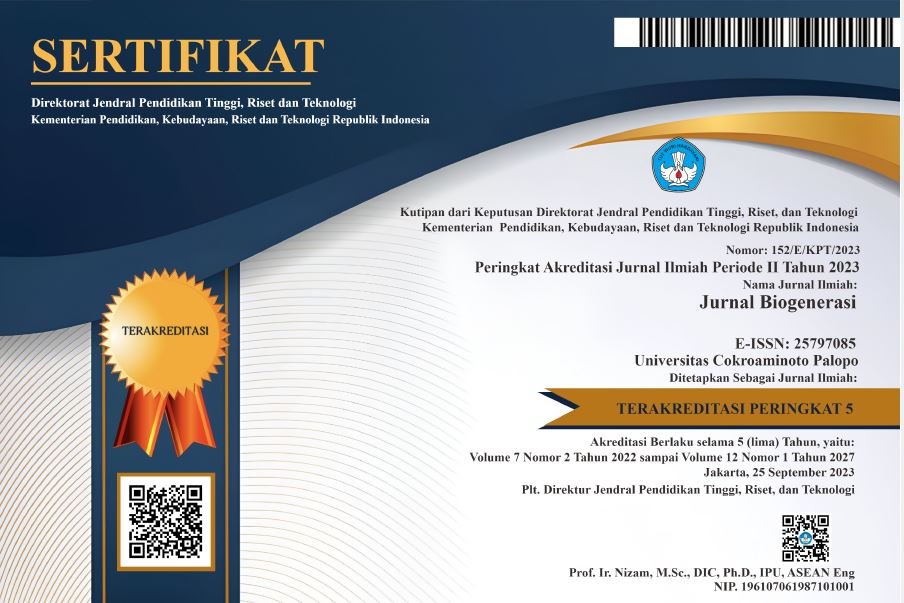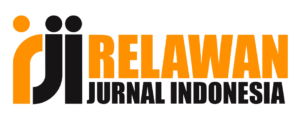Pengembangan Ensiklopedia Jamur Makroskopis Sebagai Media Pembelajaran
DOI:
https://doi.org/10.30605/biogenerasi.v9i1.3171Keywords:
Development, Encyclopedia, Instructional Media, Macroscopic FungiAbstract
The aim of this research is to test the feasibility of developing a macroscopic mushroom encyclopedia as a learning medium. This research is Research and Development (R&D) research. The research procedure adapted the ADDIE development model. The adaptation of the ADDIE model in this research was carried out at the encyclopedia validation stage. The encyclopedia validation test was carried out by two expert validators, namely a material expert validator and a media expert validator. Next, validators are asked to provide a general assessment and suggestions regarding the encyclopedia that has been developed, whether the encyclopedia is valid or invalid. Validation of the macroscopic fungal encyclopedia is in the very feasible category with a percentage of 92% by media expert validators and a percentage of 91% by material expert validators. The results of the validity test show the category is very feasible, which means that the resulting encyclopedia media does not need to be revised and is suitable for testing.
Downloads
References
Fitriani, L., Krisnawati, Y., Anorda, M. O. R., & Lanjarini, K. (2018). Jenis-Jenis dan Potensi Jamur Makroskopis yang Terdapat di PT Perkebunan Hasil Musi Lestari dan PT Djuanda Sawit Kabupaten Musi Rawas. Jurnal Biosilampari: Jurnal Biologi, 1(1), 21-28.
Jumadil., Uno, W. D., Mardin, H., Hasan, A. M., Kumaji, S. S., & Husain, I. H. (2023). Mengenal Jamur Makroskopis di Bumi Gorontalo. CV. Mitra Cendekia Media.
Nuraida, D., & Nisa, U. M. (2017, October). Pengembangan Ensiklopedia Morfologi, Anatomi dan Fisiologi pada Tumbuhan Berkarakter Khusus Development Encyclopedia of Morphology, Anatomy and Physiology in Plants with Special Character. In Proceeding Biology Education Conference Vol (Vol. 14, No. 1, pp. 503-507).
Pradana, A. P., & Masnuna, M. (2021). Ilustrasi Buku Ensiklopedia Burung Rangkong di Indonesia. ANDHARUPA: Jurnal Desain Komunikasi Visual & Multimedia, 7(01), 28-43.
Pratiwi, R. D. (2015). Pengembangan Ensiklopedia Bangun Datar Untuk Meningkatkan Hasil Belajar Siawa Kelas V MI Irsyadut Tholibin (Doctoral Diserattion) Universitas Islam Negeri Maulana Malik Ibrahim
Reski, S. H., Sari, R. P., Fransiska, S., & Fitri, R. (2023, September). Identifikasi Jenis-Jenis Jamur Makroskopis di Sekitar Pantai Gajah dan Belibis Air Tawar Barat Kota Padang Sumatera Barat. In Prosiding Seminar Nasional Biologi (Vol. 3, No. 1, pp. 875-889).
Rostikawati, R. T., & Susanto, L. H. (2019). Pengembangan ensiklopedia vertebrata untuk meningkatkan pemahaman konsep biologi siswa sma. In Prosiding Seminar Nasional SIMBIOSIS (Vol. 4).
Sri, H. (2020). Pengembangan Ensiklopedia Sebagai Media Pembelajaran (Doctoral dissertation, UIN Raden Intan Lampung).
Suharjo, E. (2010). Bertanam Jamur Merang di Media Kardus, Limbah Kapas, dan Limbah Pertanian. AgroMedia.
Suryani, Y., & Cahyanto, T. (2022). Pengantar Jamur Mikroskopis. https://digilib.uinsgd.ac.id/49533/
Downloads
Published
How to Cite
Issue
Section
License
In submitting the manuscript to the journal, the authors certify that:
- They are authorized by their co-authors to enter into these arrangements.
- The work described has not been formally published before, except in the form of an abstract or as part of a published lecture, review, thesis, or overlay journal.
- That it is not under consideration for publication elsewhere,
- That its publication has been approved by all the author(s) and by the responsible authorities – tacitly or explicitly – of the institutes where the work has been carried out.
- They secure the right to reproduce any material that has already been published or copyrighted elsewhere.
- They agree to the following license and copyright agreement.
License and Copyright Agreement
Authors who publish with this journal agree to the following terms:
- Authors retain copyright and grant the journal right of first publication with the work simultaneously licensed under Creative Commons Attribution License (CC BY 4.0) that allows others to share the work with an acknowledgment of the work's authorship and initial publication in this journal.
- Authors are able to enter into separate, additional contractual arrangements for the non-exclusive distribution of the journal's published version of the work (e.g., post it to an institutional repository or publish it in a book), with an acknowledgment of its initial publication in this journal.
- Authors are permitted and encouraged to post their work online (e.g., in institutional repositories or on their website) prior to and during the submission process, as it can lead to productive exchanges, as well as earlier and greater citation of published work.


.png)

